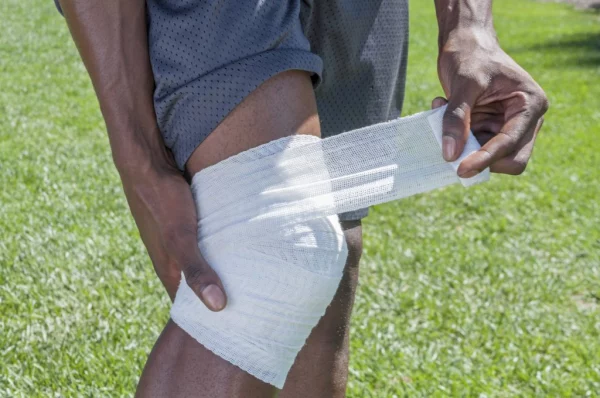Muscle strain is one of the most common injuries encountered during physical activities or sports. Whether you’re a beginner or a professional athlete, overextending or overworking your muscles can lead to damage, causing pain and interrupting your training routine. According to the American Medical Society for Sports Medicine (AMSSM), areas like the thigh muscles, calf muscles, and lower back are the most susceptible to strains. While mild cases may occur, if not treated properly, they can develop into chronic injuries.
The main causes of muscle strain include improper warm-up, poor technique, and overexertion. In some cases, muscle strain can result from lifestyle habits, such as sitting in one position for too long or lifting heavy objects incorrectly. According to Harvard Medical School (2022), warming up for 3–5 minutes before exercise helps prepare muscles and reduces the risk of injury. For example, you can perform light exercises like jogging in place or rotating your shoulders and hips to improve flexibility.
An effective method for recovering from muscle strain, as recommended by experts, is the RICE principle, which involves four basic steps:
- Rest: Allow the muscles time to recover, avoiding heavy activities that put pressure on the injured area.
- Ice: Apply an ice pack for 10–15 minutes, several times a day, to reduce swelling and alleviate pain.
- Compression: Use an elastic bandage to wrap the injured area and minimize swelling.
- Elevation: Elevate the affected area to promote better fluid and blood circulation.
“Applying the RICE principle not only helps relieve pain quickly but also speeds up muscle recovery.” – American Physical Therapy Association (2021)

In addition to the RICE method, gentle stretching exercises are also recommended once the strain has stabilized. For example, to stretch the hamstring, stand upright with your feet shoulder-width apart, and slowly bend forward until you feel a light stretch in the back of your thighs. However, avoid overstretching as it can worsen the injury. According to the British Journal of Sports Medicine (BJSM, 2020), stretching correctly for 10–15 seconds significantly improves flexibility and reduces the likelihood of recurring strains.
Preventing muscle strain begins with developing healthy exercise habits. First, establish a reasonable workout schedule, avoiding sudden increases in intensity and gradually increasing it by 10–15% per week. Technique is also crucial, especially for heavy exercises like weightlifting or long-distance running. If needed, consult a trainer or expert to improve your exercise techniques.
“Warming up and enhancing muscle flexibility not only improve athletic performance but also reduce injury risk by 50%.” – Australian Institute of Sport (AIS, 2019)
Nutrition also plays a key role in preventing injuries. Experts recommend consuming adequate amounts of protein, vitamin D, and calcium to keep muscles and bones strong. Hydration is another essential factor for maintaining muscle elasticity. Drinking enough water before, during, and after exercise helps reduce the risk of muscle cramps and sudden strains.
If you notice symptoms such as persistent pain, significant swelling, or inability to move, consult a doctor or healthcare professional promptly for examination and treatment. Ignoring muscle strain can worsen the injury and impact your mobility in the future.


HPX24h > Fitness > Muscle Strain During Exercise: Effective Prevention and Recovery Tips
Tagged Articles
Exercise – The ‘Miracle Cure’ to Awaken Overall Health
Which Exercise Burns the Most Calories? Tips for Choosing and Training Effectively
Exercise – The Key to Enhancing Your Quality of Life
Why Do You Get Headaches After Exercise? Causes, Remedies, and Effective Prevention
Top Reads from This Category
Fitness
HIIT Training: A Long-Term Remedy for Brain Health
Fitness
hould You Do Cardio or Lift Weights to Burn Calories More Effectively
Fitness
Safe Exercises for Early Pregnancy: Tips to Keep Moms Healthy and Strong
Fitness
Mesomorph: The Key to Unlocking Your Body’s Natural Strengths
Fitness
Exercise – The ‘Miracle Cure’ to Awaken Overall Health
Fitness
Which Exercise Burns the Most Calories? Tips for Choosing and Training Effectively
Fitness
Risk of Increased Mortality in Diabetics Due to Prolonged Sitting: A Warning and Action Guide
Discover New Topics
Science
Stem Cell Therapy for Lung Cancer: A New Hope Entering Human Trials
Space
The Smallest Star System with Three Exoplanets Found by NASA’s Kepler
Space
The Journey to Unveiling the Mysteries of Ancient Martian Oceans
Fitness
How Long Does It Take to Build Muscle?
Science
New Hope for the Blind: A Breakthrough in Retinal Implant Technology
Science
Discovering Enzymes That Stimulate Hair Regrowth: A New Opportunity in Hair Loss Treatment
Science
Artificial Intelligence Outperforms Humans in Treating Depression
Space
The Youngest Recorded Supernova: Unveiling the Mystery of a Star’s Death
Fitness
HIIT: The Ultimate Shortcut to Efficient and Comprehensive Fitness
Fitness
More Flexible – The Secret to Longevity?
Parenting Tips
How to Prevent a 2-Year-Old from Throwing Things?
Space
Exploring Gravitational Forces and the Evolution of the Universe
Parenting Tips
Talking To Children About Sexuality: How To Make It Easier?